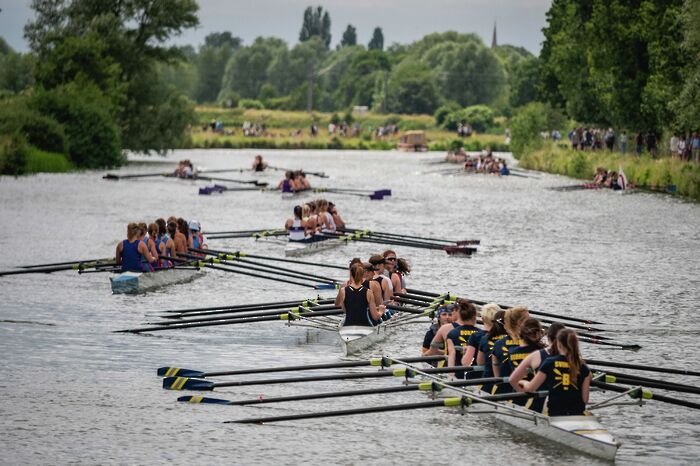The rowing one-piece: a history & style guide
Rowing fashion has evolved to produce the ultimate boatie stash: the one-piece. Annia Krzoska reveals the popular ways to style the most iconic piece in any Cambridge rower’s wardrobe

The rowing one-piece is currently a wardrobe staple for any college (or CUBC) rower, but this was not always the case. Looking through archival photos of the Boat Race, the proliferation of the one-piece coincided with the rise of Lycra around the 1970s. In the years between the first race on 10 June 1829 and today, rowing fashion has experienced several reformations.
Henley Regatta sparked some of the early rowing fashion trends with its adoption of the undergarment in the 1800s, later dubbed the “Henley shirt”. Unlike the restrictive clothing from previous years, this offered flexibility and greater ventilation, improving boat speed and increasing comfort for the rowers. The Henley shirt would be paired with shorts, allowing rowers to push with their legs without getting caught on the loose fabric of long trousers.
“The proliferation of the one-piece coincided with the rise of Lycra around the 1970s”
In the early Boat Races, the two universities are often pictured sporting matching club shirts and shorts. These shirts were tight-fitting, mitigating the risk of catching a crab or getting caught on the sliding seat (which, according to Oxford’s History of College Rowing, did not come into use until 1873). As the decades progressed, tank tops rose in popularity, allowing for greater flexibility of movement in the sweep of the blade.
Women’s and men’s rowing fashion differed in the 19th century. The University of Cambridge digital library notes that “rowers of the 1890s wore long skirts until the introduction of sliding seats made them impractical”. Shorts were introduced for Newnham rowers in the 1920s, around the same time as the first women’s Boat Race in 1927. In line with the male trend of sporting club colours, these shorts were blue to signify that the racers came from Newnham college. Women and men began to opt for similar garments, enjoying the practicality and flexibility offered by club shirts and shorts.
Godfrey Sports, one supplier of college rowing stash, first mentions the one-piece’s use in reference to Notts County Rowing in 1987. They describe their adoption of Lycra in their manufacturing process around 1985, enabling them to create a streamlined garment perfect for racing. The one-piece was more flexible than the rigid T-shirt/short combination, and avoided the irritation of shirts riding up during an intense outing.
“Since its astronomical rise in 1987, the one-piece has earned its place in many clubs’ ‘must-buy’ lists for racing rowers”
Since its astronomical rise in 1987, the one-piece has earned its place in many clubs’ “must-buy” lists for racing rowers. Different colleges sport individual one-pieces styled after college colours and college crests. Many college rowers can often be seen speeding down the river Cam in these stylish and practical pieces. Below are five iconic styles that are often the go-to choice for one-piece wearers.
The Summer

Short sleeves, no additional layers. The one-piece speaks for itself. The statement item is the perfect piece of kit for rowing over Easter term. Even on a rainy day, the one-piece is ideal as it’s quick-drying (compared to a soaked-through college puffer or T-shirt), thanks to its ability to evaporate moisture. During Easter races, the river is filled with eights with their members sporting matching one-pieces.
The Winter

During Lent term, the one-piece is often concealed beneath layer upon layer of fleeces, coats, leggings and supplemented by thermals. As practical as the one-piece may be in the summer months, it isn’t ideal for providing warmth to its wearers.
The ‘Committed Boatie’

College W1s and M1s can often be seen with their visors in place, protecting them from the sun or the rain as they hurtle down the Thames in cross-boat club races. These rowers also have a large supply of college stash, allowing them to express their endless commitment to their college and crew.
The ‘College Pride’

Each college has a variety of stash available to its rowers. St Catharine’s are famous for their “Wheel” leggings, while King’s are known for their bobble hats and love for the colour purple.
The Ballerina

While the one-piece is a unique outfit choice, it shares some traits with garments from different sports, such as the “unitard” or “unisuit”. The unitard has a similar shape to dancers’ leotards, with a similar flexibility of movement and shape assisted by the rise in Lycra. When the one-piece is paired with a long skirt or petticoat, the similarities in design are visible: for rowers who dance, the one-piece can be worn straight from dance class to boat race – practical, efficient, and of course, fashionable. The same can be said for cycling suits; the shape and material of the one-piece was an innovative move that revolutionised sporting fashion.
Given the limitations of its predecessors and its enduring popularity on the river, it seems as though the one-piece is going to remain a wardrobe staple for the Cambridge rowing community for years to come.
 News / Uni Scout and Guide Club affirms trans inclusion 12 December 2025
News / Uni Scout and Guide Club affirms trans inclusion 12 December 2025 News / Pembroke to convert listed office building into accom9 December 2025
News / Pembroke to convert listed office building into accom9 December 2025 Features / Searching for community in queer Cambridge10 December 2025
Features / Searching for community in queer Cambridge10 December 2025 News / Uni redundancy consultation ‘falls short of legal duties’, unions say6 December 2025
News / Uni redundancy consultation ‘falls short of legal duties’, unions say6 December 2025 News / Gov declares £31m bus investment for Cambridge8 December 2025
News / Gov declares £31m bus investment for Cambridge8 December 2025









